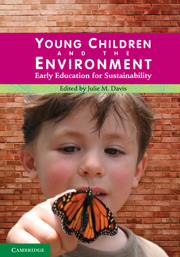Book contents
- Frontmatter
- Foreword
- Contents
- List of contributors
- Introduction
- PART 1
- Chapter 1 What is early childhood education for sustainability?
- Chapter 2 Children in the natural world
- Chapter 3 Leadership for creating cultures of sustainability
- Chapter 4 Practical possibilities and pedagogical approaches for early childhood education for sustainability
- Chapter 5 Ethics and pedagogy at the heart of early childhood education for sustainability
- PART 2
- Endnote
- Index
- References
Chapter 3 - Leadership for creating cultures of sustainability
from PART 1
- Frontmatter
- Foreword
- Contents
- List of contributors
- Introduction
- PART 1
- Chapter 1 What is early childhood education for sustainability?
- Chapter 2 Children in the natural world
- Chapter 3 Leadership for creating cultures of sustainability
- Chapter 4 Practical possibilities and pedagogical approaches for early childhood education for sustainability
- Chapter 5 Ethics and pedagogy at the heart of early childhood education for sustainability
- PART 2
- Endnote
- Index
- References
Summary
EDITOR'S NOTE
In this chapter, Megan Gibson discusses the vital role of leadership in creating change for sustainability in an early childhood education and care setting. As the past Director of Campus Kindergarten, a long-day care centre that has had a Sustainable Planet Project for over a decade, she draws on her personal experiences and perspectives and the theoretical underpinnings that helped to shape her work as an innovative leader and a leader of innovation.
Megan discusses the four frames of leadership, organisational culture, professional development and organisational change and their contributions to creating, and shaping the Sustainable Planet Project. She emphasises that the style of educational and organisational leadership plays an essential role in creating a culture of sustainability. There is emphasis on ‘whole settings’ approaches to change and the creation of ‘learning communities’ for sustainable living. The recognition of children as leaders and change agents for sustainability is highlighted.
To our children's children
The glad tomorrow
by Oodgeroo Noonuccal
(formerly Kath Walker, 1970, p. 40)AN OPPORTUNITY TO LEAD FOR EFS
For close to a decade I had the opportunity to work within the Campus Kindergarten community, a unique place for children, families and teachers. A key interest and focus on the environment during this time led to the development of the Sustainable Planet Project. From its inception at a staff professional development retreat, this project permeated the everyday ‘lifeworld’ (Sergiovanni 2003, p. 16) at the centre.
The Sustainable Planet Project was actively embraced by people from within this early childhood community, and has grown and evolved. […]
- Type
- Chapter
- Information
- Young Children and the EnvironmentEarly Education for Sustainability, pp. 76 - 103Publisher: Cambridge University PressPrint publication year: 2010
References
- 3
- Cited by



